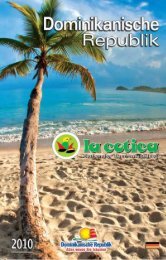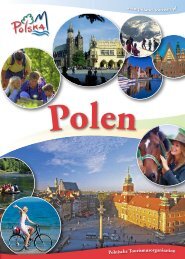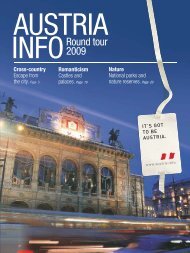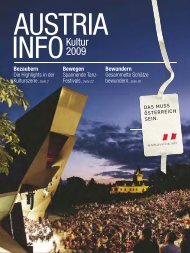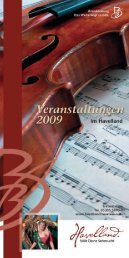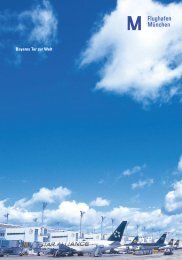i Dominican Republic - travelfilm.de
i Dominican Republic - travelfilm.de
i Dominican Republic - travelfilm.de
You also want an ePaper? Increase the reach of your titles
YUMPU automatically turns print PDFs into web optimized ePapers that Google loves.
1503. This first act of cruelty has gone<br />
down in historical records as the Jaragua<br />
Massacre. Ma<strong>de</strong> a prisoner, the Taino<br />
Queen respon<strong>de</strong>d to the heinous act with<br />
these words:<br />
“It is not honorable to kill; nor can honor<br />
propitiate the tragedy. Let us open a<br />
bridge of love, so that across it even our<br />
enemies may walk and leave for posterity<br />
their footprints.”<br />
Language<br />
Spanish is the Country’s official<br />
language. Nevertheless, in some<br />
communities that have a foreign origin<br />
and in tourist hubs English, German,<br />
French, Italian, Dutch and other<br />
languages are spoken.<br />
It is important to point out that the<br />
<strong>Dominican</strong> way of speaking is the result<br />
of our collective experiences and the<br />
wisdom of rural farmers and peasants.<br />
Our Spanish comes with a rustic accent<br />
and hinterland flavor and in our country<br />
each region has its own accent, charm<br />
and peculiar expressions, which usually<br />
i<strong>de</strong>ntify the speaker from the very moment<br />
he or she opens his or her mouth.<br />
This unique form of expression has been<br />
a source of inspiration for renowned<br />
writers, both native and foreign. It is<br />
not known precisely when the common<br />
country parlance started to be used in<br />
literary writings. Nevertheless a rustic<br />
poem written in 1635 by Tirso <strong>de</strong> Molina<br />
earned a literary award— the rustic lilt<br />
10<br />
had been immortalized thanks to his<br />
sojourn between 1616 and 1618 at the<br />
Convent of Las Merce<strong>de</strong>s in the colonial<br />
zone of Santo Domingo.<br />
Despite the prepon<strong>de</strong>rance of Spanish<br />
culture, several words from the Taino’s<br />
melodious and sweet language remain<br />
in use and have become a part of<br />
the everyday lingo. Nearly all these<br />
terms preserve their original meaning.<br />
For example:ají (pepper), barbacoa<br />
(barbecue), batea (trough or small tub),<br />
bija (anatto fruit), bohío(hut), burén (flat<br />
griddle), canoa (canoe), carey (tortoiseshell),<br />
caribe (Caribbean),casabe<br />
(cassava), coa (sharp wood rod), conuco<br />
(a plot of land for cultivation),guanábana<br />
(soursop), guayaba (guava), hamaca<br />
(hammock), higüera (calabash tree),<br />
Place of the flag, Santo Domingo.



